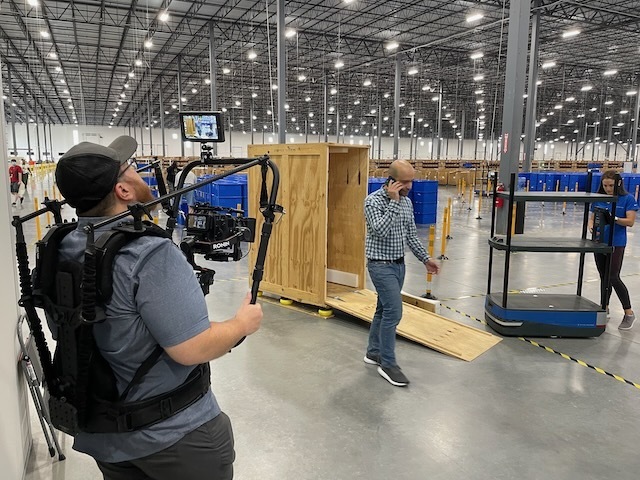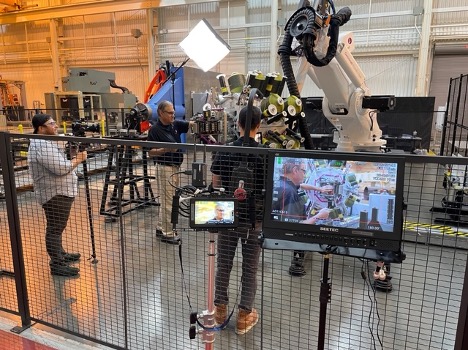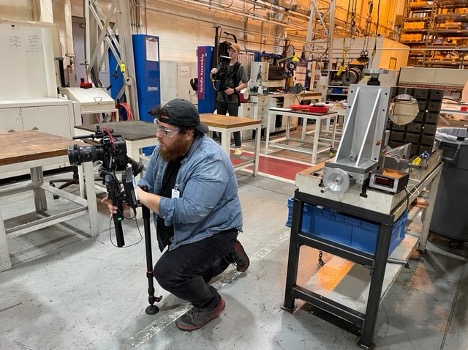Barking Squirrel Media is a film production company located in Cincinnati, Ohio. We tell the stories of organizations that make a positive impact in real people’s lives, the community and the world. Over the past ten years, Barking Squirrel Media has traveled throughout the United States and Europe, producing mini-documentaries, corporate brand films and manufacturing videos.
The Challenge of Travel
We love the opportunity to trek the world! However traveling with camera equipment on planes can be expensive and challenging. Up until 2020, as DP of Barking Squirrel Media, I primarily used RED Cinema Cameras for all commercial work. I loved the image quality that came out of my REDs as long as I was able to properly light the scenes. When you travel the world with a small production team it is critically important to be as light as possible. Therefore, touting heavy bags is exhausting. A small team can only carry so many camera’s, lights, grip and V mount batteries. The challenge is to be as light as possible without sacrificing image quality.
The Equipment Requirements
I realized that we need equipment that will maintain the stunning cinema images of a RED cinema camera. Additionally it must also be small and light for travel and have sensors that will handle the low light settings that documentary film makers require. I researched the most versatile cinema camera systems available to solve this problem. Quite a few options were available for great documentary cameras. Luckily they all pretty much rock.
Originally I thought about getting the RED Komodo, but there were a few things I wasn’t crazy about, especially the cost of the media. Over the years we have invested thousands of dollars in proprietary media for our RED digital cinema cameras. And yet we always seem to need more. But the price is significant.
The Komodo is no different in this arena. It offers high quality images, but at a hefty price tag on media. Unfortunately the battery life is similar to that of our old REDs (about 60 min for a 95wh amount). Therefore, I looked into the Sony and Canon systems that offer auto focus, a tool I have never been able to trust in the RED ecosystem.
I rented a Canon C70 from Lensrentals.com and had a great time shooting several spots for one of our clients. The camera’s built in ND filters and professional audio controls allowed me to shoot documentary footage with ease. Additionally, if the subject walked outside for a scene, I could easy put up to 10 stops of ND in front of the sensor to keep my depth of field nice and shallow.
The Advantage of AutoFocus and Internal ND Filters
I was also able to trust the autofocus feature to find the subject’s face and keep their eyes in focus. The 10-bit color and clean image coming out of this camera was amazing. It was the same as its big brother, the Canon c300iii, but at a fraction of the cost. The battery life was fabulous! It rocked a 3 hour runtime with the smaller BP-A30 size. This all came from a camera only slightly bigger than my Canon EOS R.
The only downside for the C70 for the past two years was that it didn’t offer a RAW option. That being said, I found that the XF-AVC files were plenty beefy enough for anything I threw at them in Davinci Resolve or Lumetri. I have filmed quite a few green screen projects at this point and the codec held up.
C-70 RAW Light Firmware Update
As I am writing this, I learned that the Canon C70 cinema camera is now getting a firmware update in March for Cinema RAW light. This was the only thing holding it back from being the ultimate little beast. Needless to say, I found my camera of choice for most of the jobs we ended up filming in 2020-202.
I paired the small form factor of the Canon C70 with the DJI RS2 Pro, creating a powerhouse rig that can be used on a Steadicam, a jib, a tripod or my favorite a monopod (my team dubbed this the wizard staff). The flexibility of being able to switch the gimbal head from one device to another allows my team to pull off creative shots without sacrificing tons of setup time.
(Pictured above is the “Wizard staff setup”, a Steadicam hydraulic monopod, paired with a DJI RONIN RS2, CANON C70, SIGMA ART 18-35mm and RODE WIRELESS GO II mics. Next to me is Matt Henkes running B Cam; a CANON C70 with .071x Speed Booster, SIGMA ART 70-200mm, SMALL HD INDIE 7 monitor and HOLLYLAND WIRELESS VIDEO TRANSMISSION. Both systems being sent to separate monitors for real time director and client monitoring)
(Pictured above is the “Wizard staff setup”, a Steadicam hydraulic monopod, paired with a DJI RONIN RS2, CANON C70, SIGMA ART 18-35mm and RODE WIRELESS GO II mics. Behind me is Matt Henkes running B Cam; a CANON C70 with .071x Speed Booster, SIGMA ART 70-200mm, SMALL HD INDIE 7 monitor and HOLLYLAND WIRELESS VIDEO TRANSMISSION)
Conclusion
After purchasing 2 Canon C70 Cameras, I have almost exclusively switched over to using these systems for all our shoots. Having two cameras that fit easily in flight cases while also having gimbal support in a smaller package has been the biggest improvement. Many of our clients are looking for the high end cinematic look and this new gear allows us to tackle any shooting environment without sacrificing quality.
Dan Marque
Director of Photography
Barking Squirrel Media, LLC



